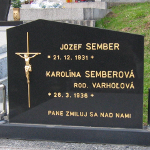----- Part 1 of 3 -----
“In this world nothing can be said to be certain, except death and taxes.” – Benjamin Franklin“They say death and taxes are the only things that are inevitable. The truth is, you can not pay your taxes. I've done it, and there's consequences, but it can be done. Death you're not going to get out of, and you kind of got to deal with it.” – Steve Earle
November is a month when Catholics pray for the dead. One thing we know for certain: you are going to die, and there's no way out of it. To be human is to face death and come to grips with it. If we look back to the Victorian era, just a century or two ago, death and grieving were woven into the fabric of society. Gathering around the deathbed of a relative was a sacred ritual. Whole families, including children, took time praying and keeping vigil. They listened closely for any last words the dying said that might give clues about the other side. Too often, though, death was sudden and tragic, the result of a runaway horse, factory fire or plague. It could come at any time; people were always prepared for death.
When a person died, their body would be taken home, washed by their own relatives, dressed and laid out. The more well-to-do had a special room on their house, called the parlor, used only for formal guests and for laying out the body. The body would be laid out over night as friends and neighbors came to pay their respects, socialize, and also party. Some of our older parishioners remember as youngsters going from house to house to partake of the food and libations on offer. That night was passed as a vigil or “wake”. The next day the family would walk their loved one over to church where a solemn Requiem Mass in black with chant would be offered for their eternal rest. Their loved one would then be escorted to the cemetery. The townspeople would pause in their work to remove their hats and salute the funeral cortège as it passed. The body was always buried in blessed ground, unless it was a suicide.
The burial was not the end of the journey. The widow of the deceased and other close relatives would don black clothes and special armbands as a sign they were in mourning. They would not be expected out at parties or to otherwise lead a normal life for a while. Often this was a period of a month, but some widows dressed in mourning for years. Society even sold special jewelry to be worn by the mourning.
In the last 100 years, modern society has pushed death to the fringes of our mind, much like electric light has banished darkness. Funeral “Parlors” offered to host the reception for the family. We began to embalm and put on makeup; our dead look better than they did when they were alive. Everything is scheduled around a convenient time. Some come but don’t even stay for the funeral because it isn’t convenient. We rush right back into the daily routine, as though the rift in our lives will disappear if we don’t spend too much time mourning. We cannot control death so we ignore it, and we have begun to lose touch with death. This has also caused us to lose touch with life. We cannot truly live unless we come to grips with the reality of death. November is a good time to walk in a cemetery, pray for the dead, and reflect on life and death. Death is inevitable but it is not the end. However, death can be a great teacher to those who are not afraid to listen and learn.
